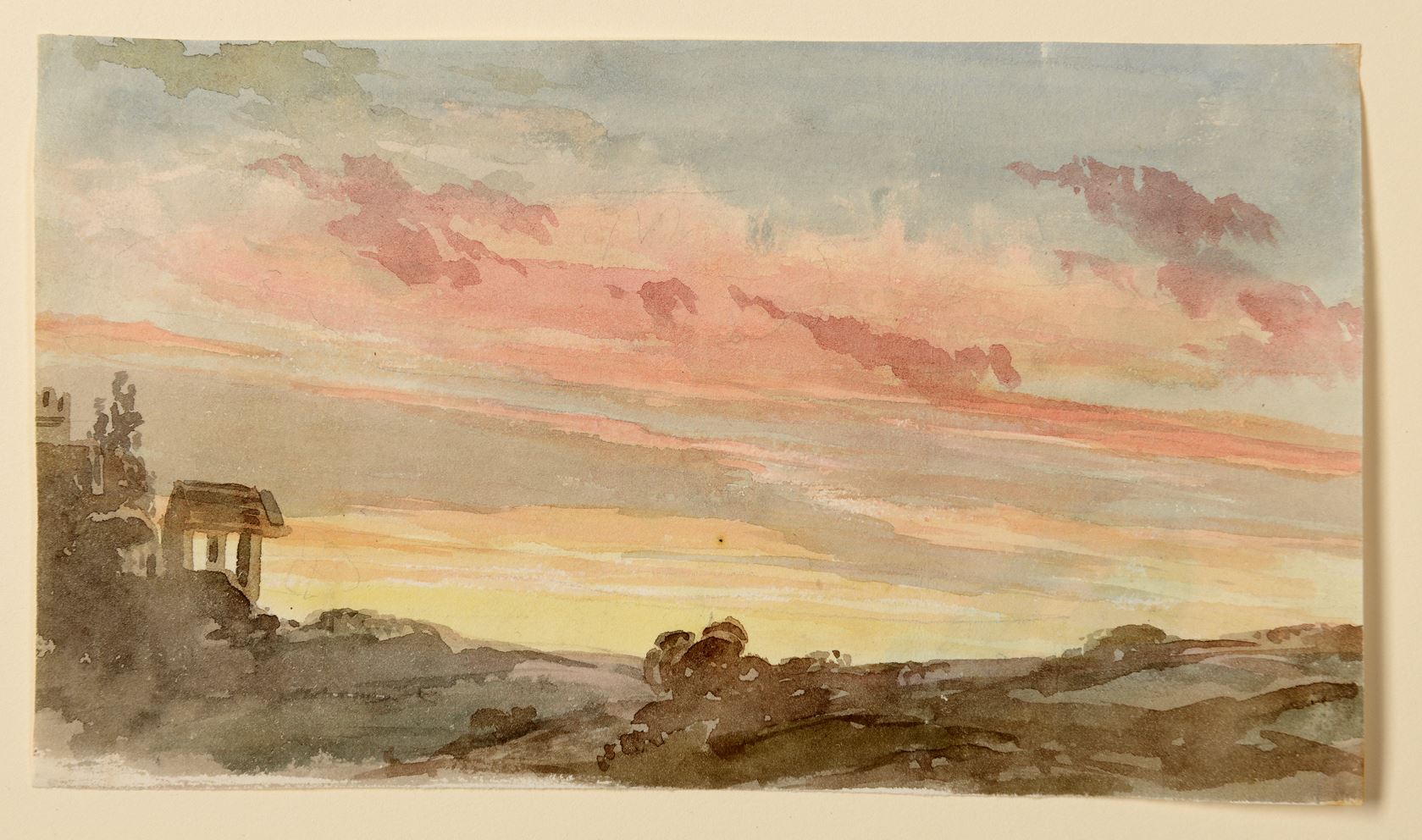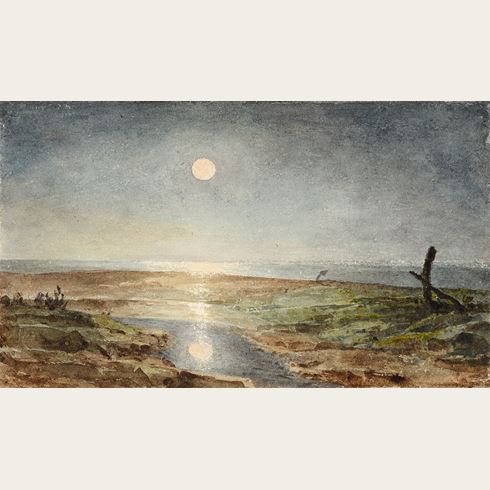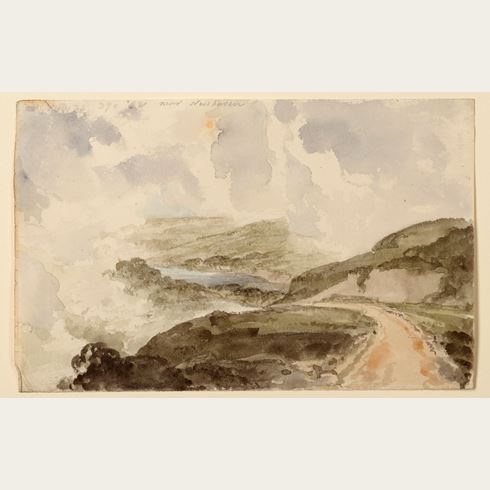Joseph Michael GANDY
(London 1771 - Plympton 1843)
Sunset
Watercolour, over an underdrawing in pencil.
A sketch of a large church (St. Paul’s Cathedral, London?) in pencil on the verso.
117 x 201 mm. (4 7/8 x 7 7/8 in.)
A sketch of a large church (St. Paul’s Cathedral, London?) in pencil on the verso.
117 x 201 mm. (4 7/8 x 7 7/8 in.)
The present sheet was one of several landscape sketches by Jospeh Gandy from the 1820s which were acquired from him by his friend, the Neoclassical sculptor Sir Richard Westmacott (1775-1856). Westmacott had studied in Rome with Gandy, and sometimes purchased works from his often impecunious friend. He later assembled these watercolours into two albums which he gave to his daughter Maria Poole. One of these albums is today in the Sir John Soane Museum in London, while the other album was eventually broken up and the drawings dispersed in 2004.
The present sheet was part of this second album, which was titled GANDY / VOL II / LANDSCAPE on the spine, and inscribed, by Richard Westmacott, Gandy’s sketches / I give / Maria on the inside cover. The album contained 97 watercolours of landscapes and studies from nature, variously inscribed and dated between the 15th of July 1820 and the 5th of July 1826. The album contained watercolour landscapes drawn in London and its outskirts, as well as various views in Surrey, East and West Sussex, and Kent on the southeast coast of England, as well as a number of studies of skies, clouds, sunsets, storms and nocturnal views. Many of the watercolours – which appear to have come from one or more sketchbooks used by the artist - were inscribed by Gandy with the location, date and time that the views were made, as well as the compass direction of the view chosen.
As the Gandy scholar Brian Lukacher has written of the drawings from the two Westmacott albums, ‘[Gandy’s] acute responsiveness to landscape topography and the transient conditions of nature is also revealed in over 175 small-scale watercolor sketches from the late 1810s and 1820s that have no apparent relation to antiquarian publications. The inscriptions on these drawings allow us to chart Gandy’s travels around the outskirts of London, along the Thames, through Sussex, and down to the southeast coast. Some sequences of watercolours document an afternoon’s worth of topographic sketching. Although many of the landscapes focus on the quintessentially picturesque aspects of English village scenery, a large number also depict urban, suburban, and industrial topography...Whatever the larger purpose behind Gandy’s topographic sketches of castle ruins and working landscapes around Great Britain, they were never to be incorporated into a systematic publication under his direction.’
Lukacher adds that ‘Gandy’s drawings often bear notations indicating the time of day or night that the view was observed and rendered: a twilit landscape of the enclosed commons at Milton, a late afternoon stormy landscape rent by a flash of lightning, or unidentified nocturnes with distinctive atmospheric phenomena seen in the scarlet dyeing of early evening clouds or in the moon encircled by a hazy pink numbus. The science and poetry of meteorology is often the primary focus of these optically alert drawings.’
‘Many of these watercolours are also quintessentially picturesque in both style and imagery. Serpentine country lanes and undulating streams guide the eye through scenographically composed landscape masses that frame an unsettled sky, a setting sun, or a rising moon...A rapt mood of contemplative isolation permeates the twilit and nocturnal landscapes. A picturesque lens persistently intervened between Gandy and the topography he was surveying. The site specificity and documentary pretexts of these watercolors did not preclude them from containing poetical microcosms of picturesque Britain – more a byproduct of imaginative fabrication than naturalistic observation.’
The present sheet was part of this second album, which was titled GANDY / VOL II / LANDSCAPE on the spine, and inscribed, by Richard Westmacott, Gandy’s sketches / I give / Maria on the inside cover. The album contained 97 watercolours of landscapes and studies from nature, variously inscribed and dated between the 15th of July 1820 and the 5th of July 1826. The album contained watercolour landscapes drawn in London and its outskirts, as well as various views in Surrey, East and West Sussex, and Kent on the southeast coast of England, as well as a number of studies of skies, clouds, sunsets, storms and nocturnal views. Many of the watercolours – which appear to have come from one or more sketchbooks used by the artist - were inscribed by Gandy with the location, date and time that the views were made, as well as the compass direction of the view chosen.
As the Gandy scholar Brian Lukacher has written of the drawings from the two Westmacott albums, ‘[Gandy’s] acute responsiveness to landscape topography and the transient conditions of nature is also revealed in over 175 small-scale watercolor sketches from the late 1810s and 1820s that have no apparent relation to antiquarian publications. The inscriptions on these drawings allow us to chart Gandy’s travels around the outskirts of London, along the Thames, through Sussex, and down to the southeast coast. Some sequences of watercolours document an afternoon’s worth of topographic sketching. Although many of the landscapes focus on the quintessentially picturesque aspects of English village scenery, a large number also depict urban, suburban, and industrial topography...Whatever the larger purpose behind Gandy’s topographic sketches of castle ruins and working landscapes around Great Britain, they were never to be incorporated into a systematic publication under his direction.’
Lukacher adds that ‘Gandy’s drawings often bear notations indicating the time of day or night that the view was observed and rendered: a twilit landscape of the enclosed commons at Milton, a late afternoon stormy landscape rent by a flash of lightning, or unidentified nocturnes with distinctive atmospheric phenomena seen in the scarlet dyeing of early evening clouds or in the moon encircled by a hazy pink numbus. The science and poetry of meteorology is often the primary focus of these optically alert drawings.’
‘Many of these watercolours are also quintessentially picturesque in both style and imagery. Serpentine country lanes and undulating streams guide the eye through scenographically composed landscape masses that frame an unsettled sky, a setting sun, or a rising moon...A rapt mood of contemplative isolation permeates the twilit and nocturnal landscapes. A picturesque lens persistently intervened between Gandy and the topography he was surveying. The site specificity and documentary pretexts of these watercolors did not preclude them from containing poetical microcosms of picturesque Britain – more a byproduct of imaginative fabrication than naturalistic observation.’
An architect by profession, Joseph Gandy was trained in the office of James Wyatt from 1786 onwards, before enrolling in the Royal Academy Schools in 1789. Following a period of three years spent in Rome, he returned to London where he was employed as a draughtsman by the architect Sir John Soane, for whom he began working in 1798. Although long regarded by scholars as merely an employee of Soane, translating the latter’s architectural designs into full-scale watercolours, it is now known that Gandy often produced drawings after his own inventions. (That he was certainly held in high regard by Soane is shown in the comments made by the architect in a lecture presented at the Royal Academy in 1813: ‘A superior manner of Drawing is absolutely necessary, indeed it is impossible not to admire the beauties and almost magical effects in the architectural drawings of a Clérisseau, a Gandy, or a Turner.’) Gandy maintained a modest architectural practice of his own, and regularly exhibited a remarkable series of large-scale architectural history watercolours and capriccios - grandiose subjects inspired by Ancient Greece and Rome – in the architecture section at the Royal Academy between 1789 and 1833. (He also showed fourteen works at the British Institution in 1820 and 1821). In 1803, Gandy was admitted as an Associate of the Royal Academy, largely on the strengths of his undoubted skills as an architectural draughtsman, and despite the fact at that time he had not received any commissions as a practicing architect. (Indeed, he achieved no further promotion within the Academy, and was never elected an Academician.) Gandy also produced a number of designs for stage sets, and contributed drawings to the antiquarian topographer John Britton’s The Architectural Antiquities of Great Britain, published between 1807 and 1826, and The Cathedral Antiquities of England, which appeared between 1814 and 1835.
Provenance
Acquired from the artist by Richard Westmacott and placed into an album
The album given to his daughter, Maria Poole, née Westmacott
Thence by descent until sold, London, Christie’s, 20 November 2003, lot 7
Richard L. Feigen & Co., New York.
The album given to his daughter, Maria Poole, née Westmacott
Thence by descent until sold, London, Christie’s, 20 November 2003, lot 7
Richard L. Feigen & Co., New York.
Exhibition
New York, Richard L. Feigen & Co., Joseph Gandy: Visionary Views of England, 2004, no.87; Little Rock, Arkansas Art Center, 43rd Collectors Show and Sale, 2011, no.28.






